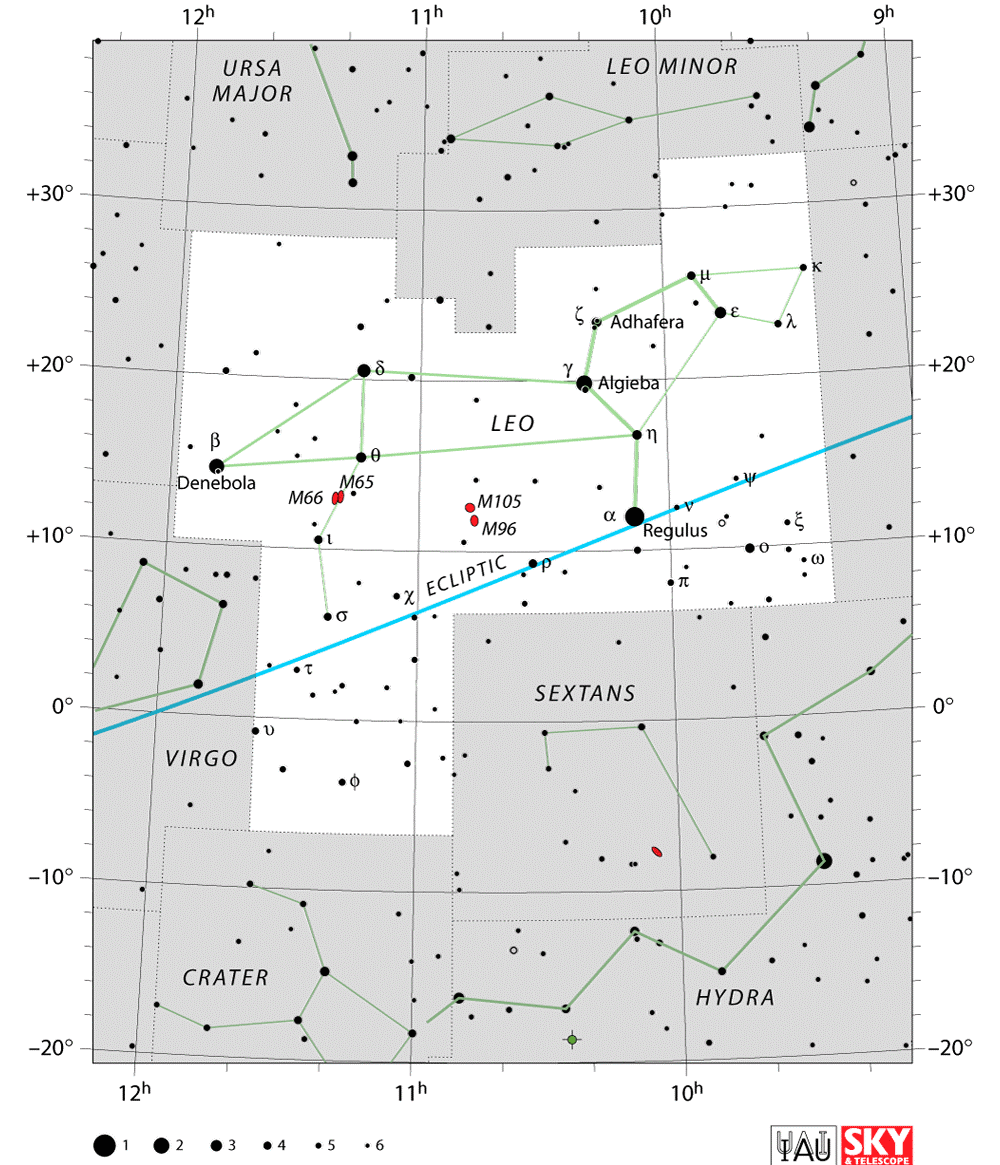



Leo
Leo is one of the easiest constellations to recognize, and has been pictured as a lion by many different cultures since ancient times, including by the Indians, Persians, and Greeks. It is the 12th largest constellation in the night sky, and rather hard to miss with a ‘sickle of stars’ forming the front part of its distinctive sphinx-like figure. Leo contains the 22nd brightest star in the entire night sky, Regulus, a blue-white star located 77 light year from Earth, which also forms part of a distinctive asterism of stars called the Spring

Like several constellations Leo is based on the adventures of Hercules, a Greek mythological hero and son of Zeus. After being driven insane by his step mother the divine hero killed his six sons in a blind rage. When he recovered from his temporary madness Hercules seeked to atone for his actions by serving a penance for his crimes. Eventually Hercules ended up in the control of King Eurystheus who set him a series of labors.The first of these labors was to kill a lion that had been terrorizing the city of Nemea. Unknown to Hercules the lion had a coat of golden fur which arrows and swords were unable to penetrate. On his first visit to the lion’s lair Hercules discovered that his arrows simply bounced of the beast. On his second visit the hero blocked off one of the two entrances to the lair and entered armed with a large club, he beat the lion with his club before strangling it to death.
Mythology


Location

March does come in with a lion. The constellation becomes visible in the Northern Hemisphere around the spring equinox and is easily identifiable through May. Leo lies between Cancer to the west and Virgo to the east.
-
Right ascension: 11 hours
-
Declination: 15 degrees
-
Visible between latitudes 90 and minus 65 degrees
-
Best seen in April at 9 p.m.


Deep Sky Objects in Cancer
Messier 65 (M65, NGC 3623)
-
Messier 65 is an intermediate spiral galaxy in Leo. It has an apparent magnitude of 10.25 and is approximately 35 million light years distant.
-
The galaxy was discovered by Charles Messier in 1780. Messier 65, Messier 66 and NGC 3628 form the famous Leo Triplet galaxy group.
-
The galaxy does not contain much dust and gas and there isn’t much star formation occurring in it. Most of the stars in the galaxy are old.
-
M65’s disk appears slightly warped, which, along with some recent starburst activity, suggests that the galaxy is interacting with another object.
Messier 66 (M66, NGC 3627)
-
Messier 66 is an intermediate spiral galaxy in Leo.
-
Charles Messier discovered it in 1780.
-
The galaxy has a visual magnitude of 8.9 and is about 36 million light years distant.
-
M66 is approximately 95,000 light years across and notable for its dust lanes and bright star clusters.
-
It is part of the Leo Triplet, along with M65 and NGC 3628.
Messier 95 (M95, NGC 3351)
-
Messier 95 is a barred spiral galaxy in Leo.
-
It has a visual magnitude of 11.4 and is approximately 38 million light years distant.
-
The central region of M95 has a ring-shaped starburst region around the core with a diameter spanning about 2,000 light years.
-
The galaxy was discovered by the French astronomer Pierre Méchain in 1781 and Charles Messier subsequently included it in his catalogue four days later.


The Leo Ring
-
The Leo Ring is an enormous primordial cloud of hydrogen and helium found in orbit of two galaxies in the Leo constellation. The cloud was discovered by radio astronomers in 1983.
NGC 3607
-
NGC 3607 is a spiral galaxy in Leo. It has a visual magnitude of 10.8 and is a member of the Leo II Group (NGC 3607 Group) of galaxies.
NGC 3593
-
NGC 3593 is a spiral galaxy in Leo. It has an apparent magnitude of 12.6.
NGC 3384
-
NGC 3384 is an elliptical galaxy, approximately 35.1 million light years distant. It was discovered by William Herschel in 1784.
-
The stars located in the galaxy’s central region are very old. More than 80% of them are Population II stars, more than a billion years old.
-
NGC 3384 belongs to the M96 Group (Leo I Group) of galaxies.
NGC 3842
-
NGC 3842 is an elliptical galaxy, notable for having one of the largest black holes known. The black hole at the centre of the galaxy is believed to have a mass of 9.7 billion solar masses.
-
The galaxy has an apparent magnitude of 12.8 and is approximately 331 million light years distant from Earth.